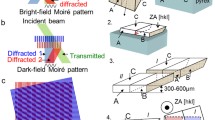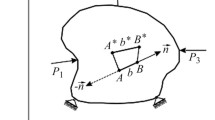Abstract
The complete state of strain throughout an extended field can be determined from a single photograph by the moiré grid-analyzer method. Grids are used for the active, or specimen screen, and for the rigid analyzer screen. Hence, two families of moiré fringes appear simultaneously, providing displacements inx andy directions throughout the field.
Interweaving of moiré fringes so as to disguise the identity of each family is prevented by use of an initial pattern. The initial pattern also eliminates uncertainties in assignment of moiré fringe orders throughout the field, and it provides numerous data points in any local region for reliable evaluation of fringe gradients. A rigorous derivation is presented for interpretation of such patterns in terms of strains.
Errors in computed shear strains caused by analyzer misalignment are automatically canceled. The effects of rigid-body rotation of elements within the specimen are routinely eliminated in strain computations. Since calculated strains are independent of analyzer orientation, no fine control of analyzer alignment is required, and small shifts of analyzer position during the experiment are permissible. Accordingly, the moiré grid-analyzer method not only makes possible analysis of problems that previously could not be approached, but also offers vast simplifications for all extended-field moiré analyses.
Similar content being viewed by others
References
Dantu, P., “Extension of the Moiré Method to Thermal Problems,”Experimental Mechanics,4 (3),64–69 (1964).
Meier, J. H., “Strain Rosettes,”Handbook of Experimental Stress Analysis, Hetényi, M., ed., John Wiley and Sons, Inc., N. Y. (1950).
Diruy, M., “L'Analyse des Contraintes par la Methode des Reseaux Optiques,” DOCAERO No. 55 (March 1959).
Dantu, P., “Utilisation des Reseaux pour l'etude des Deformations,” Annales de l'Institut de Batiment et des Travaus Publics, No. 121 (January 1958).
Theocaris, P. S., “The Moiré Method in Thermal Fields,”Experimental Mechanics,4 (8),223–231 (1964).
Weller, R. andShepard, B. M., “Displacement Measurement by Mechanical Interferometry,”Proc. SESA, VI (1)35–38 (1948).
Theocaris, P. S., “Moiré Fringes: A Powerful Measuring Device,” Appl. Mech. Rev.,15 (May 1962).
Duncan, J. P. andSabin, P. G., “An Experimental Method for Recording Curvature Contours in Flexed Elastic Plates,”Experimental Mechanics,5 (1),22–28 (1965).
Author information
Authors and Affiliations
Additional information
Work reported here was sponsored by Vishay Instruments, Inc.
Rights and permissions
About this article
Cite this article
Post, D. The moiré grid-analyzer method for strain analysis. Experimental Mechanics 5, 368–377 (1965). https://doi.org/10.1007/BF02326085
Issue Date:
DOI: https://doi.org/10.1007/BF02326085




